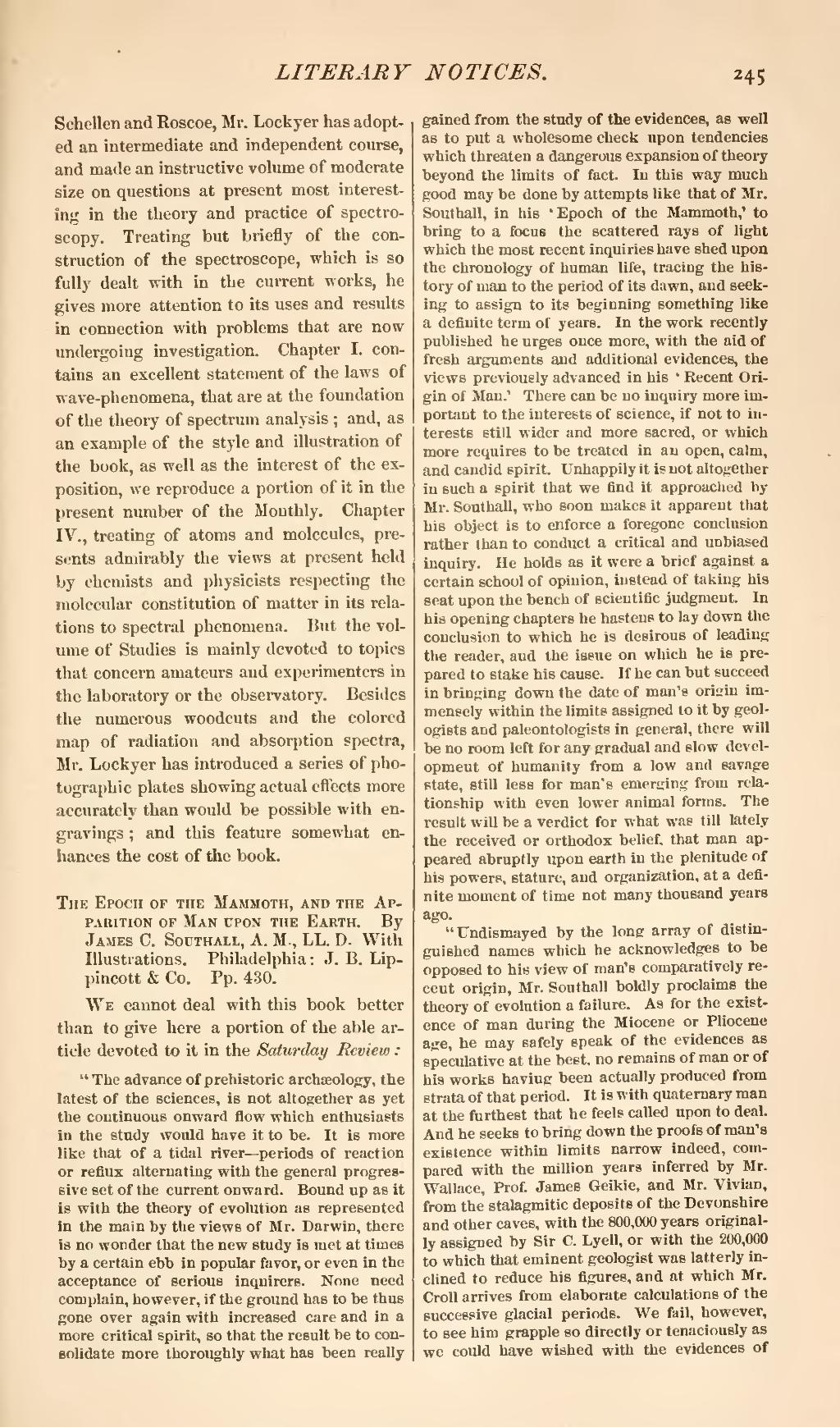Schellen and Roscoe, Mr. Lockyer has adopted an intermediate and independent course, and made an instructive volume of moderate size on questions at present most interesting in the theory and practice of spectroscopy. Treating but briefly of the construction of the spectroscope, which is so fully dealt with in the current works, he gives more attention to its uses and results in connection with problems that are now undergoing investigation. Chapter I. contains an excellent statement of the laws of wave-phenomena, that are at the foundation of the theory of spectrum analysis; and, as an example of the style and illustration of the book, as well as the interest of the exposition, we reproduce a portion of it in the present number of the Monthly. Chapter IV., treating of atoms and molecules, presents admirably the views at present held by chemists and physicists respecting the molecular constitution of matter in its relations to spectral phenomena. But the volume of Studies is mainly devoted to topics that concern amateurs and experimenters in the laboratory or the observatory. Besides the numerous woodcuts and the colored map of radiation and absorption spectra, Mr. Lockyer has introduced a series of photographic plates showing actual effects more accurately than would be possible with engravings; and this feature somewhat enhances the cost of the book.
The Epoch of the Mammoth, and the Apparition of Man upon the Earth. By James C. Southall, A. M., LL. D. With Illustrations. Philadelphia: J. B. Lippincott & Co. Pp. 430.
We cannot deal with this book better than to give here a portion of the able article devoted to it in the Saturday Review:
"The advance of prehistoric archæology, the latest of the sciences, is not altogether as yet the continuous onward flow which enthusiasts in the study would have it to be. It is more like that of a tidal river—periods of reaction or reflux alternating with the general progressive set of the current onward. Bound up as it is with the theory of evolution as represented in the main by the views of Mr. Darwin, there is no wonder that the new study is met at times by a certain ebb in popular favor, or even in the acceptance of serious inquirers. None need complain, however, if the ground has to be thus gone over again with increased care and in a more critical spirit, so that the result be to consolidate more thoroughly what has been really gained from the study of the evidences, as well as to put a wholesome check upon tendencies which threaten a dangerous expansion of theory beyond the limits of fact. In this way much good may be done by attempts like that of Mr. Southall, in his 'Epoch of the Mammoth,' to bring to a focus the scattered rays of light which the most recent inquiries have shed upon the chronology of human life, tracing the history of man to the period of its dawn, and seeking to assign to its beginning something like a definite term of years. In the work recently published he urges once more, with the aid of fresh arguments and additional evidences, the views previously advanced in his 'Recent Origin of Man.' There can be no inquiry more important to the interests of science, if not to interests still wider and more sacred, or which more requires to be treated in an open, calm, and candid spirit. Unhappily it is not altogether in such a spirit that we find it approached by Mr. Southall, who soon makes it apparent that his object is to enforce a foregone conclusion rather than to conduct a critical and unbiased inquiry. He holds as it were a brief against a certain school of opinion, instead of taking his seat upon the bench of scientific judgment. In his opening chapters he hastens to lay down the conclusion to which he is desirous of leading the reader, and the issue on which he is prepared to stake his cause. If he can but succeed in bringing down the date of man's origin immensely within the limits assigned to it by geologists and paleontologists in general, there will be no room left for any gradual and slow development of humanity from a low and savage state, still less for man's emerging from relationship with even lower animal forms. The result will be a verdict for what was till lately the received or orthodox belief, that man appeared abruptly upon earth in the plenitude of his powers, stature, and organization, at a definite moment of time not many thousand years ago.
"Undismayed by the long array of distinguished names which he acknowledges to be opposed to his view of man's comparatively recent origin, Mr. Southall boldly proclaims the theory of evolution a failure. As for the existence of man during the Miocene or Pliocene age, he may safely speak of the evidences as speculative at the best, no remains of man or of his works having been actually produced from strata of that period. It is with quaternary man at the furthest that he feels called upon to deal. And he seeks to bring down the proofs of man's existence within limits narrow indeed, compared with the million years inferred by Mr. Wallace, Prof. James Geikie, and Mr. Vivian, from the stalagmitic deposits of the Devonshire and other caves, with the 800,000 years originally assigned by Sir C. Lyell, or with the 200,000 to which that eminent geologist was latterly inclined to reduce his figures, and at which Mr.
Croll arrives from elaborate calculations of the successive glacial periods. We fail, however, to see him grapple so directly or tenaciously as we could have wished with the evidences of
